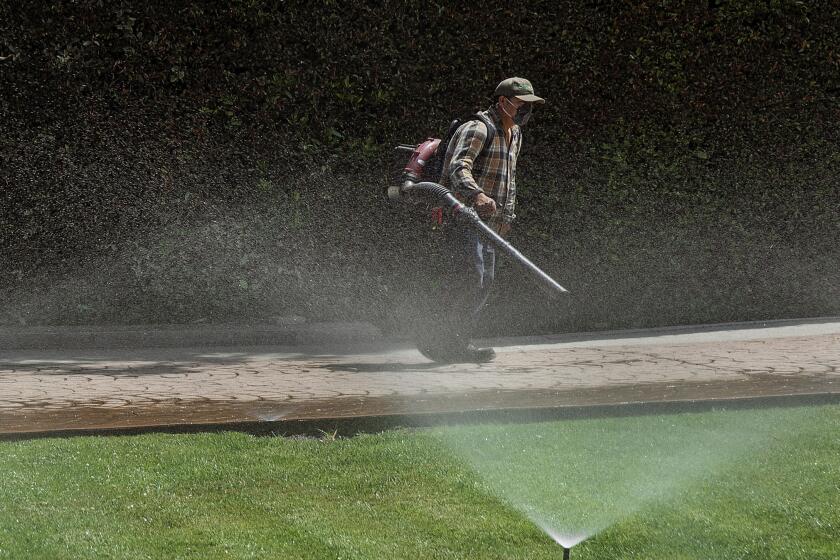Vertical gardening gurus share strategies
- Share via
The vertical gardening craze has generated all sorts of nifty products that can be attached to a fence, filled with soil and succulents and — voilà — you have a living wall.
But according to the authors of “Garden Up! Smart Vertical Gardening for Small and Large Spaces,” a Cool Springs Press book released this year, your garden’s upright surfaces can be planted in other ways — many involving materials you already have on hand.
Bay Area designers Susan Morrison and Rebecca Sweet have two decades of combined experience designing hundreds of gardens, and along the way “we’ve learned that almost any space can benefit from a few vertical gardening techniques,” says Morrison, owner of Creative Exteriors Landscape Design and a founding member of the Lawn Reform Coalition. Her coauthor, Sweet, writes for Horticulture magazine and has a design practice called Harmony in the Garden. Together they shared ideas for making the most of the garden’s vertical surfaces:
What inspired this book?
Morrison: People have a tendency to focus on planting beds, patios and other places at ground level, but we know that really great gardens also cause you to look up — and that means taking advantage of vertical spaces that already exist, such as fences and walls, as well as ones you create yourself with arbors, trellises or architectural plants.
How do you define vertical gardening?
Sweet: It’s not just about living walls, but also about getting your money’s worth from your property’s vertical potential — and using fences, walls, railings and structures as part of the garden.
Morrison: When you think about it, gardeners have been using vertical techniques forever — to grow food, disguise an eyesore or add a chic personal touch to a space.
What can you do with an ordinary cinder-block wall?
Sweet: A lot of people think, “I’m going to plant a vine to cover it and call it a day.” But we love it when people get creative and use that surface for displaying collections or artwork. You can use vintage ladders, gates or even an old headboard as the trellis to train vines and climbing plants. Theresa Loe, whose garden is in El Segundo, decorated her cinder-block wall with all sorts of vintage elements, what used to be a bland expanse of concrete is now one of the most charming parts of her garden.
What about a chain-link fence?
Morrison: One of my clients started with lightweight wooden lattice and cut out random sections to create an interesting geometrical pattern. Then she stained it dark red and ended up with an artful backdrop. In the center of this, she mounted a rattan screen, also stained red. This ingenious treatment adds a warm maroon glow at the back of the shade garden, and you forget the chain-link fencing is even there.
What are your favorite screening techniques?
Sweet: If you have the space, select a tall, narrow tree. A favorite for California gardens is compact cherry laurel (a type of Prunus caroliniana called Compacta), which grows about 15 feet tall. You can limb it up as a tree or clip it as a hedge. Another great option is box leaf azara (Azara microphylla), which has small leaves, tiny yellow flowers and an airy habit.
In my own garden, I only have 51/2 inches of planting space in front of the fence. I planted a Sally Holmes rose, which I trained to grow high above the fence. Along the mid-portion is an espaliered kumquat tree, and at its feet are mounding succulents. On the fence itself, I mounted a small shelf, which holds a potted string-of-pearls.
Is there a place for edibles in vertical gardening?
Morrison: Absolutely. You can also create your own vertical veggie garden from recycled objects. Emily Goodman, one of the most innovative gardeners we met while researching the book, turned her San Francisco apartment courtyard into a wall-to-wall edible garden. She did it by planting her herbs in old wood filing drawers. She planted lettuces in felt pockets she sewed herself using closet shoe organizers for inspiration. Our favorite trick: Emily turned a PVC pipe into a 5-foot-tall strawberry tower.
If each of you has only one piece of advice for using the vertical landscape, what would it be?
Sweet: Layer up, not out, which means maximizing the top, middle and bottom levels of your vertical space. The top layer calls for tall, narrow shrubs, small trees and vines; prune or train them into a vase shape to leave room for additional layers below. The middle layer should feature plants with tall flower stalks or finely-textured ornamental grasses with a vertical, light and airy habit. Then the bottom layer can have ground-hugging shrubs, compact perennials and foliage plants.
Morrison: Treat your vertical spaces like canvases, and use them to create a garden that’s uniquely your own, whether that means displaying a treasured collection of watering cans, planting a vegetable garden or in my case, painting a wall purple and decorating it with porthole mirrors from Target. Ultimately, we hope our book inspires gardeners to look at their gardens through fresh eyes.






